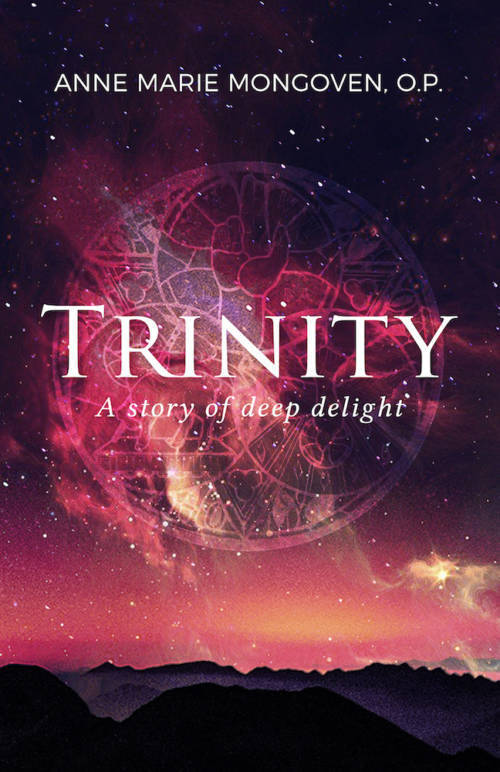Reviewed by Mary Paynter, O.P.
Long ago, St. Augustine wrote a long and ponderous theological study entitled De Trinitate (On the Trinity). Down the centuries ever since, other theologians have tried their hands at trying to explain what belief in the Trinity means—often in theological jargon, over the heads of most Christians. Karl Rahner, S.J., the influential twentieth-century theologian, once wryly recognized that “Christians are, in their practical lives, almost mere ‘monotheists.’”
Now, Anne Marie Mongoven’s slim (and very readable) book Trinity: A Story of Deep Delight brushes away the highfalutin’ language of erudite theologians as she shares her refreshing insights into this mystery in down-to-earth language. Her sub-title indicates what this theological exploration means to her—“deep delight”—and that is what she shares with the reader.
Probably for most Christians, faith in God is centered in Jesus and what we know about Him from the Gospels. The parables, the sayings of Jesus, the details of his life, death, and resurrection—all are humanly understandable and often vividly imagined in devout believers. Still, the main Christian faith formulations—Apostolic, Nicene, and Athanasian creeds—all posit the Trinity as a core element of Christian belief. Yet for today’s “person-in-the-pew” at Sunday worship or immersed in daily realities, what does belief in the Trinity mean? Can an ordinary person even “imagine” the Trinity? Is it a mathematical puzzle? Is God the Father to be seen as an old man with a long white beard? Is God the Holy Spirit imagined as a dove or as a tongue of flame?
Mongoven points out that “there is a problem with images of Trinity….we need to change our images [and] …do away with exclusively male imagery.” She suggests that one way to initiate change would be to “use the formula of the Trinity suggested in the 5th century by St. Augustine: using his words, we could pray the doxology, ‘Glory be to our Lover, our Beloved, and the Love who unifies us.’” Yet, she adds, “Images remain problematic, for Trinity can never be adequately described in human terms. John the beloved apostle stated simply that ‘God is love,’ and that is the best we can do.” And this is what her book is all about.
In the introduction, Mongoven says, “I write about Trinity because the mystery of God is so embracing, enlightening, and enabling that I cannot not write about it….This book is primarily a meditation on Trinity as God who is Love. It is a pastoral writing that reflects not only on the nature and love of God, but also on the implications of Trinity’s relationship with humans and all creation.”
 Mongoven’s “deep delight” is explored in five chapters. The first deals with the central theme of the book—relationships, those within the Trinity, and the relationships between the Trinity and all of creation, particularly with humankind. Her second chapter reviews the many images used for God the Creator/Father (and here she introduces St. Augustine’s relational and gender-neutral imagery). Chapter 3 explores the names and images used by the early Christian communities for Jesus and the Trinity. Chapter 4 reflects on images of the Spirit found in Scripture and in two classic medieval hymns, Veni Creator Spiritus and Veni Sancte Spiritus. Chapter 5 describes Trinity’s relationship with humankind as one of friendship-love.
Mongoven’s “deep delight” is explored in five chapters. The first deals with the central theme of the book—relationships, those within the Trinity, and the relationships between the Trinity and all of creation, particularly with humankind. Her second chapter reviews the many images used for God the Creator/Father (and here she introduces St. Augustine’s relational and gender-neutral imagery). Chapter 3 explores the names and images used by the early Christian communities for Jesus and the Trinity. Chapter 4 reflects on images of the Spirit found in Scripture and in two classic medieval hymns, Veni Creator Spiritus and Veni Sancte Spiritus. Chapter 5 describes Trinity’s relationship with humankind as one of friendship-love.
This brief summary of the contents fails to indicate the engaging simplicity and clarity with which the author draws the reader into the text. However, a few quotes from the text offer the flavor and texture of her writing. For example, when analyzing key passages from Scripture, she unfolds them gracefully to the reader. In Chapter 3, she explores two Christological hymns—Philippians 2:5-11 and Colossians 1:15-20. She sees the Colossian hymn as being different from Philippians, in that the cosmic images of Christ show him as the one who envelops the whole of creation with love:
Christ’s relationship to all reality is astounding. All that is relates to the Christ, and the Christ includes all that is in universal love. The community at Colossae sang of the Christ as ‘the fullness of God.’ This is a song of worship. It was undoubtedly sung at communal prayer. It is strong, powerful poetry, resembling the Prologue of John’s Gospel. It is an astonishing text that expresses the Christ’s Trinitarian bond of love as well as his bond of love for the church of Colossae and for all of Creation…. The imagination of the writer and of the worshippers stretched beyond Earth, beyond Nazareth, Jerusalem, and Israel, beyond the warrior nations that neighbored them, beyond what they could see or touch or even imagine.”
Toward the end of her book, and with reference to 1 Cor. 12:13, she addresses the reader directly: “Knowing that the Triune God is Love itself gives us extraordinary insight into our own humanity. For the moment, discard whatever it is that hides your view of God and consider what faith and hope and love can mean in your life…. Recognizing God as a loving Trinity enables human beings to sing and dance and live with deep delight.”
This book would be a good choice for personal study and for small group discussions. It can engage people at any level of religious education, because it takes a fresh look and opens a new window of understanding the mysterious and amazing reality that “God is Love,” as reflected in personal experiences of human love and friendship as well as through Scripture.
April 2019
If you would like to purchase a copy of Trinity: A Story of Deep Delight you can click here.

